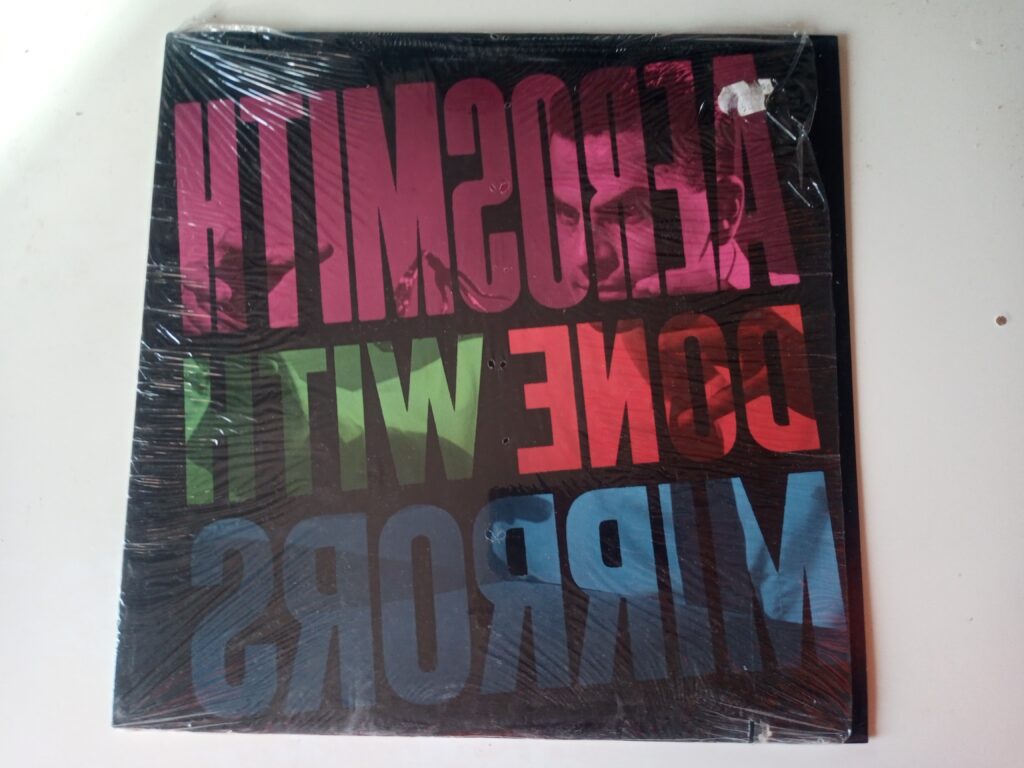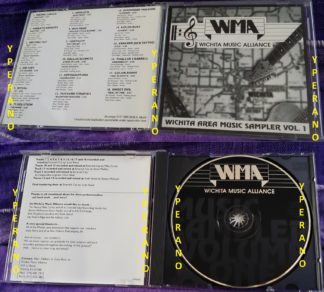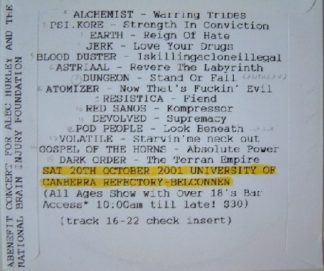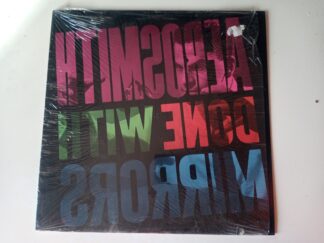Description
Check the exclusive video, showing the vinyl for sale!
Check the exclusive video, showing the vinyl for sale!
Done with Mirrors is the eighth studio album by American rock band Aerosmith, released on November 4, 1985. It marked the return to the band of guitarists Joe Perry, who left in 1979 and Brad Whitford, who departed in 1981. The band’s first album on Geffen Records, it was intended as their ‘comeback’. However, the record failed to live up to commercial expectations despite positive reviews.
Background
“Let the Music Do the Talking” was a rerecording of the title track from first album by the Joe Perry Project, with altered lyrics and melody.
Brad Whitford revealed that producer Ted Templeman wanted to capture the band’s aggressive, “out of control freight train” sound by removing the red light indicating that recording was underway (a technique he had used to capture Van Halen’s sound). Templeman told the band to run through the songs in the studio and recorded them without their knowledge. Whitford referred to the nerves generated when knowingly recording songs as “the red light blues”.
“I had a great time making that record,” Templeman told The Washington Post’s Geoff Edgers, “and Steven was one of the most amazing guys. But we had to do that record in Berkeley because they didn’t want those guys to score (drugs). They didn’t want them to be in L.A. or San Francisco. I wasn’t familiar with the board. As a producer, if you know your room and the mic preamps, you know how things are going to sound. I don’t think I made Joey’s drums sound as good as they could have or Joe’s guitar.”
Viacom (MTV & VH1) executive Doug Herzog recalled that, after this album, “Aerosmith was done… They were a little bit of a joke.” However, they would revive their career in 1986 with a landmark remake of 1975’s “Walk This Way” with hip-hop group Run DMC, followed by an album that would eventually go 5× Platinum – Permanent Vacation – in 1987.
Done with Mirrors is the last Aerosmith record written without the aid of outside songwriters, as of Music from Another Dimension!
The title refers both to illusions that are “done with mirrors”, and the laying out of drugs such as cocaine, traditionally snorted off a mirror.
Reception
On VH1 Classic’s That Metal Show, Joey Kramer expressed his dislike of Done with Mirrors, claiming the band “never really finished it”.
Joe Perry was similarly dismissive: “Done with Mirrors, as far as I’m concerned, is our least inspired record. But I’ve heard fans really like it so I’m not gonna stand there and tell ’em, ‘No, it sucks.’ We had to do that record to get to the next one so it served its purpose. I just don’t think it’s up to the standard of some of our others.”
[Despite the band’s views, this album earned mostly positive reviews].
In 2022 Aerosmith guitarist Joe Perry said he’s come to appreciate the value of the band’s 1985 “comeback” album Done With Mirrors.
Despite being a commercial disappointment, the band’s first record after the return of Perry and fellow guitarist Brad Whitford represents an important moment in its career, Perry told Vinyl Writer Music in a recent interview.
“We had just gotten back together, and we had done a tour,” he said. “That whole tour was really about getting comfortable playing together again… that was part of the reason we went on the road without a record deal. Well, it was one of them, because we honestly couldn’t get a record deal. We had burned so many bridges, and nobody would sign us!”
He continued: “But you know, we wanted to see if we could still do it. We needed to know if the old spark was there. So we went out and toured on that idea alone… [and] the fans showed up for us. After we did that, we knew that was it. We knew that was what we were there for.”
The tour’s success led to a new recording contract, but Perry said the group first had to spend time “learning to write again.” He explained: “You would think that after doing records like Rocks, Draw the Line, and of course the first three records, you would think that we would be able to pick up from there and go on, but that wasn’t the case. The pressure was on, and people were looking at us like, ‘Okay, nice tour. Now what are you going to come out with?'”
He accepted that the resulting LP didn’t live up to everyone’s expectations, blaming it on the pressure the band faced. Perry said that’s also why Aerosmith didn’t make the most of their team-up with long-time Van Halen producer Ted Templeman. “I guess we were expecting more from him, and so we were kind of nervous to work with him, and I think he was nervous to work with us, which kind of surprised us,” the guitarist reflected. “It was a funny dynamic. I don’t know, I always felt like that record could have been better if we worked on it some more, or if everybody said, ‘You know, we kind of feel uptight about working with you.'”
Perry revisited Done With Mirrors a few years ago when it made a list of the most under-appreciated rock records. “I realized it was raw, and it was a lot like the first album,” he said. “We just went in and straight-up recorded in the studio. It was as simple as going in, plugging in, turning the machines on, and we went from there. So that happened, and I started listening to it, and I was really surprised now that I was looking at it differently.”
Noting the “raw and dirty” feel of the songs, he continued: “I still wish I could have maybe polished a few more things, or maybe put a couple more overdubs on it, but all in all, I think it did what it was supposed to do. I think it kind of showed me what we needed to do, what we were, and where we needed to be for the next one.”
After Done With Mirrors, Aerosmith collaborated with Canadian super-producer Bruce Fairbairn on their next three multi-platinum smashes, Permanent Vacation, Pump and Get a Grip, which solidified their comeback and returned them to the top of the rock heap. “I think we had to get through Done With Mirrors,” Perry said, “to get to that next step and push ourselves to that next level.”
Track listing
No. Title Writer(s) Length
1. “Let the Music Do the Talking” (The Joe Perry Project cover) Joe Perry 3:48
2. “My Fist Your Face” Steven Tyler, Perry 4:23
3. “Shame on You” Tyler 3:22
4. “The Reason a Dog” Tyler, Tom Hamilton 4:13
5. “Shela” Tyler, Brad Whitford 4:25
6. “Gypsy Boots” Tyler, Perry 4:16
7. “She’s on Fire” Tyler, Perry 3:47
8. “The Hop” Tyler, Hamilton, Joey Kramer, Perry, Whitford 3:45
Total length: 35:42
Personnel Aerosmith
Steven Tyler – lead vocals, piano, harmonica, percussion
Joe Perry – guitar, slide guitar, backing vocals
Brad Whitford – guitar, acoustic guitar
Tom Hamilton – bass guitar
Joey Kramer – drums, percussion
Production
Ted Templeman – producer
Jeff Hendrickson – engineer, mixing
Tom Size, Gary Rindfuss, Stan Katayama – assistant engineers
Howie Weinberg – analog mastering engineer at Masterdisk, New York
Ken Caillat – digital mastering
Joan Parker – production coordinator
Kent Ayeroff – album cover concept
Norman Moore – art direction and design
Jim Shea – photography
John Kalodner – A&R
Chart (1985) Peak position
Canada Top Albums/CDs (RPM) 72
Japanese Albums (Oricon) 41
US Billboard 200 36
Certification
Region Certification Certified units/sales
United States (RIAA) Gold 500,000^
^ Shipments figures based on certification alone.
Label: Geffen Records – GHS 24091
Format: Vinyl, LP, Album
Country: US
Released: 1985
Style: Hard Rock, Classic Rock, AOR
A1 Let The Music Do The Talking 3:44
A2 My Fist Your Face 4:21
A3 Shame On You 3:38
A4 The Reason A Dog 4:11
B1 Shela 4:32
B2 Gypsy Boots 4:13
B3 She’s On Fire 3:44
B4 The Hop 3:39
Record Company – Warner Communications
Record Company – Diogenes Productions Inc.
Manufactured By – Warner Bros. Records Inc.
Phonographic Copyright ℗ – The David Geffen Company
Copyright © – The David Geffen Company
Pressed By – Specialty Records Corporation
Published By – Aerosmith
Published By – Daksel Music Corp.
Published By – Waban Hill Music
Recorded At – Fantasy Studios
Recorded At – Power Station
Recorded At – Can-Am Recorders
Mixed At – Can-Am Recorders
Mixed At – Power Station
Mastered At – Masterdisk
Art Direction, Design – Norman Moore
Bass – Tom Hamilton
Coordinator [Production] – Joan Parker
Crew [Aerosmith Crew] – Jay Fortune, Patrick O’Neil, Toby Francis
Design Concept [Album Cover Concept] – Jeffrey Kent Ayeroff
Drums – Joey Kramer
Engineer [Second] – Garry Rindfuss, Stan Katayama, Tom Size
Engineer, Mixed By – Jeff Hendrickson
Guitar – Brad Whitford
Guitar, Backing Vocals – Joe Perry
Lacquer Cut By – HW*
Lead Vocals, Piano, Harmonica – Steven Tyler
Management – Collins/Barrasso, Inc.*, Steve Barrasso, Tim Collins
Mastered By [Originally] – Howie Weinberg
Performer, Written-By – Aerosmith
Photography By – Jim Shea
Producer – Ted Templeman
Recorded at Fantasy Recording, Berkeley, California
Additional Recording and Mixing at The Power Station, New York and
Can-Am Recorders, Tarzana, California
Issued with a printed inner sleeve
Specialty pressing with slightly different labels and runout details than Done With Mirrors and Done With Mirrors
Barcode: 0 7599-24091-1
Matrix / Runout (Runout side A/B, stamped): MASTERDISK SRC
Matrix / Runout (Runout side A, etched): GHS-◼24091-A RE1 SR-2 1-4 MIA
Matrix / Runout (Runout side B, etched): GHS-2-4091-B-SR2 HW M̶̲̅J̶̲̅A̶̲̅ 1-2
Matrix / Runout (Runout side A, etched – Variant 2): GHS-◼24091-A REI SR-2 1-1 SMW MIA
Matrix / Runout (Runout side B, etched – Variant 2): GHS-2-4091-B-SR2 M̶̲̅J̶̲̅A̶̲̅ 1-2
Matrix / Runout (Runout side A, etched – Variant 3): GHS-◼24091-A-RE1-SR1 1-2 MIA HW
Matrix / Runout (Runout side B, etched – Variant 3): GHS-2-4091-B-SR2 HW M̶̲̅J̶̲̅A̶̲̅ 1-2
Matrix / Runout (Runout side A – Variant 4): GHS- ̶Z̶ 24091-A RE1 SR-2 1-1 MIA
Matrix / Runout (Runout side B – Variant 4): GHS-2-4091-B-SR2 HW ̶M̶I̶A̶ 1-2
Matrix / Runout (Runout side A – Variant 5): GHS-◼24091-A-RE1-SR1 1-2 MIA
Matrix / Runout (Runout side B – Variant 5): GHS-2-4091-B-SR1 HW 1-1
Matrix / Runout (Runout side A – Variant 6): GHS-◼24091-A-RE1-SR1 1-2 MIA
Matrix / Runout (Runout side B – Variant 6): GHS-2-4091-B SR1 1-1SM1-1
Rights Society: BMI
Other (Embossed on centre label side B): E A S T
In purely commercial terms, Aerosmith‘s improbable resurrection after seven years in career purgatory began in 1986.
That year, frontman Steven Tyler and guitarist Joe Perry appeared on Run-D.M.C.’s ground-breaking hip-hop remake of the Aerosmith classic “Walk This Way.” Propelled in part by an unforgettable and inescapable video, the new re-imagined version became a runaway hit that out-performed the original and jump-started Aerosmith’s comeback.
According to then-manager Tim Collins, the band’s blockbuster second act – a run of three multi-platinum albums starting with 1987’s Permanent Vacation – simply couldn’t have happened without every member of the group doing his part to conquer individual addictions. They did (at least for a time), and the rest, as they say, is history. In the U.S. alone, Aerosmith went on to sell five million copies of Permanent Vacation and seven million apiece of the two albums that followed, 1989’s Pump and 1993’s Get a Grip.
By contrast, Aerosmith’s reunion album Done With Mirrors sold poorly after its arrival on Nov. 9, 1985, taking a full eight years to scratch its way to gold certification. As music critic Chuck Eddy wrote in a guest essay for Richard Bienstock’s photo book Aerosmith: The Ultimate Illustrated History of the Boston Bad Boys: “Not much time passed before [Tyler and Perry were] apologizing for the album.”
Certain critics were even more disparaging than the band, which has shared plenty of negative comments in various outlets over the years. Media members at a lavish listening party “went catatonic” on hearing the music, according to Boston Globe contributor Steve Morse. He called the album “terrible,” comparing it to “bad Motley Crue.”
Still, Done With Mirrors plays a pivotal part in the Aerosmith story. (Incidentally, in both the aforementioned essay and his own book Rock and Roll Always Forgets, Eddy proposes that it was his review that inspired Run-D.M.C. producer Rick Rubin to approach Aerosmith about a collaboration.)
The band’s first offering for Geffen, Done With Mirrors marked the return of Perry and rhythm guitarist Brad Whitford, who had quit in 1979 and 1982, respectively. Naturally hyped as a return to form after Aerosmith soldiered on with replacement guitarists Jimmy Crespo and Rick Dufay, the album captures the reunited original fivesome practically wallowing in a nastiness that nothing else in their catalog touches.
It’s not that other Aerosmith songs (“Uncle Salty,” “Lightning Strikes,” “Monkey on My Back” – take your pick) don’t go down some dark alleys, but throughout the nine songs here, Tyler references all manner of depravity – including underage prostitution, underage drug use, general drug use, more drug use, sex with a sex partner’s younger sister (with drugs present), possible prison sex and a shady character named Julio Afrokeluchie.
If opening track and lead-off single “Let the Music Do the Talking” has a more celebratory tone than the rest of the album, that’s because it was originally recorded by Perry’s solo vehicle the Joe Perry Project. Tyler overhauled the lyrics and melody, but he didn’t quite go as dark as he does on the rest of the songs.
Though difficult at times to get a coherent sense of what the songs are about (good luck deciphering “My Fist Your Face,” for example) you do get enough pictures from Tyler’s stream-of-consciousness sleaze to understand that he’s coming from a gritty place. It’s also clear that the specter of drug abuse still loomed large over the band at this point. (Amusingly enough, the “Let the Music Do the Talking” video shows them hanging out with a group of teenage bootleggers after a show at a hilariously straight-laced afterparty where Whitford, bassist Tom Hamilton, and drummer Joey Kramer stand stiffly, looking more like chaperones than rock stars.)
But no matter how much damage Tyler had done to himself, his motormouth tongue-twisting wit was still intact. Done With Mirrors gave us the line “the reason a dog has so many friends is ’cause he wags his tail instead of his tongue” – a turn of phrase that should by all rights have made it into everyday parlance back in 1985.
Done With Mirrors is noticeably devoid of the power ballads, outside songwriting doctors and the titillating-but-safe-for-the-mall sexuality that would characterize the band’s next three albums. And while Aerosmith certainly sound re-energized on Permanent Vacation and Pump, on Done With Mirrors they sound like they have something to prove as they climb out of a filth-encrusted, needle-littered gutter. Songs like “Let the Music Do the Talking,” “My Fist Your Face,” “Shame on You,” etc., slink along with that trademark Aerosmith boogie, but the rhythm section maintains an almost threatening swagger in its grooves.
Producer Ted Templeman, fresh off his extraordinary streak at the helm for Van Halen‘s first six albums, captured Aerosmith’s spirit at its most ragged and scrappy. Listening to Done With Mirrors alongside the albums Aerosmith made before and after it, you have to wonder if – at least attitude-wise – the gutter is where this band truly belonged. For better or worse, they never returned to that same headspace again, which makes Done With Mirrors both a new beginning and the end of an era.


















